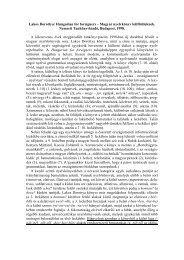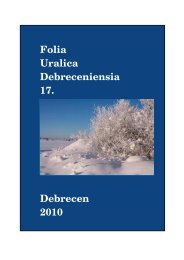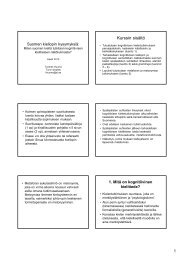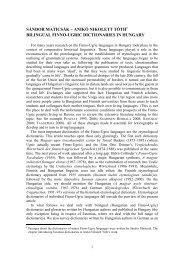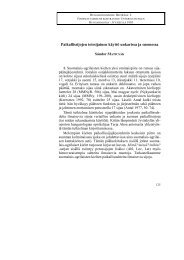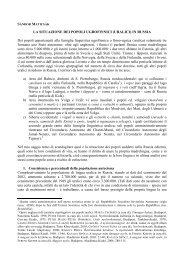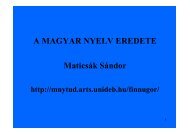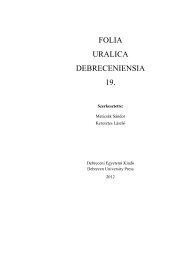Allomorphic variants of Erzya-Mordvin nominal derivational suffixes
Allomorphic variants of Erzya-Mordvin nominal derivational suffixes
Allomorphic variants of Erzya-Mordvin nominal derivational suffixes
Create successful ePaper yourself
Turn your PDF publications into a flip-book with our unique Google optimized e-Paper software.
3.1.2. The -v suffix is also a frequent and productive de<strong>nominal</strong> adjectival suffix (Bartens 1999:110–111; Cygankin 1981: 46–47; EK 38; Feoktistov 1966: 183; Grammatika 1962: 41–42;Grammatika 1980: 112; Keresztes 1990: 66; Mészáros 1988: 102; Serebrennikov 1967: 78–79). Itslinking rules are the same as that <strong>of</strong> the genitive and lative case endings. From a descriptive point <strong>of</strong>view, the suffix takes up the -v/-ev/-ov forms (although, only Mészáros uses this form).c) After stems ending in a vowel, it is -v (piźemev ’rainy’ ← piźeme ’rain’, usav ’moustached’ ←usa ’moustache’, varmav ’windy’ ← varma ’wind’); after stems ending in a consonant, it takesup the -Vv form.d) After front-vocalic stems, the form <strong>of</strong> the suffix is -ev (kevev ’stony’ ← kev ’stone’, kežev’angry’ ← kež ’anger’, ľemev ’fatty’ ← ľem ’fat’); after back-vocalic stems, it is -ov: porov’chalky’ ← por ’chalk’, počtov ’floury’ ← počt ’flour’, rudazov ’muddy; dirty’ ← rudaz’mud’, sakalov ’bearded’ ← sakal ’beard’.e) When the stem-final consonant is palatalized, the suffix is used in the -ev variant (even if thestem is back-vocalic!): čemeńev ’rusty’ ← čemeń ’rust’, vijev ’strong’ ← vij ’strength’; umaŕev’made with apples’ ← umaŕ ’apple’, śovońev ’clayey’ ← śovoń ’clay’. The -ov form is used ifthe stem-final consonant is non-palatalized: (rudazov).3.1.3. The -j suffix is synonymous with the former -v, with the difference that it is considerablyless frequent (Bartens 1999: 110–111; Cygankin 1981: 46–47; EK 38; Feoktistov 1966: 183;Grammatika 1980: 112; Keresztes 1990: 66; Mészáros 1998: 102; Serebrennikov 1967: 78–79).From a descriptive point <strong>of</strong> view, the suffix takes up the -j, -ej forms, although only Mészáros givesthese forms and we find -j in all the other sources.c) After stems ending in a vowel, the form <strong>of</strong> the suffix is -j (keľej ’wide; spacious’ ← keľe’width’, pitńej ’expensive’ ← pitńe ’price; value’, sepej ’bitter’ ← sepe ’bile; bitter taste’);after stems ending in a consonant, an additional -e connective vowel is added before the suffix(kežej ’angry’ ← kež ’anger’, pŕevej ’clever’ ← pŕev ’reason, sense’). 33.1.4. The -t, -ť suffix is not productive anymore. It is infrequent as a suffix <strong>of</strong> de<strong>nominal</strong> nouns, butsomewhat more common as a deverbal suffix (Cygankin 1981: 46; 2000c: 149–150; EK 37;Grammatika 1980: 107; Keresztes 1990: 67; 2011: 46).a) The stem-final vowel is deleted when the suffix is added to verbal stems: košt ’air’ ← košta- ’to(become) dry, to wither’, ťeńśť ’broom’ ← ťeńśe- ’to sweep’, veťśť ’rein, leash’ ← vetśe- ’tolead, to carry somewhere’.b) Sometimes – when the suffix is not added to a passive root, but a verbal derivative word – theentire last syllable <strong>of</strong> the verbal stem may be deleted: pečť ’piece, slice’ ← pečke- ’to cut (<strong>of</strong>f)’,počt ’flour’ ← počodo- ’to sprinkle, to powder’, śolt ’pond’ ?← śolgo- ’to shut, to close’.c) It is added to de<strong>nominal</strong> stems ending in a consonant without a connective vowel inserted: gajť’sound, voice’ ← gaj ’ringing, noisy’, onkśť ’bridle-bit’ ?← onks ’moderation’. Inonomatopoeic words, the suffix is attached to a semantically obscure passive root (not existingindividually anymore) ending in a consonant: šalt ’hum, clamour, noise’ (cf. šalno- ’to hum, toclamour’), uvt ’hum’ (cf. uvno- ’to hum’), zujť ’shiver’ (cf. zujńe- ’to tremble, to shiver’), źeŕť’rumble’ (cf. źeŕńe- ’to rumble’).d) The -ť variant is used after front-vocalic stems (pečť, ťeńśť), the -t after back-vocalic stems(košt, počt).e) The suffix takes up the -ť form after stems ending in a palatalized consonant (even if the stemis back-vocalic!): gajť, ťeńśť, zujť; the -t variant is used after stems ending in a non-palatalizedconsonant (košt, šalt).3 C.f. in addition tanťej ’tasty; sweet’, which probably goes back to the tan-/tant- root, c.f. tanśť ’taste; sweets’.5



